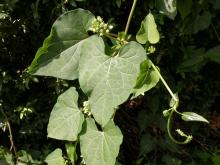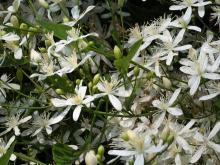Wildflowers, Grasses and Other Nonwoody Plants
Media

Species Types
Scientific Name
Pueraria montana
Description
Of the many invasive nonnative plants that were originally introduced to stop soil erosion and improve soils, kudzu is one of the worst. This “vine that ate the South” is often the first plant that comes to mind when we think of “invasive plants.”
Media

Species Types
Scientific Name
Dioscorea oppositifolia (sometimes called D. batatas)
Description
Similar to kudzu, Chinese yam is an aggressive vine that overtakes nearly everything within reach that stands still long enough! Learn more about this invasive plant — and please don’t plant it!
Media

Species Types
Scientific Name
Galium aparine
Description
The tiny white flowers of this native plant are not very memorable, but the curious, sticky-feeling whorls of narrow leaves and lightweight, 4-sided stems make cleavers unique. And then there’s the tiny, round, “Velcro” covered balls of the seeds, which “stick tight” to your socks!
Media

Species Types
Scientific Name
Commelina communis
Description
The flowers of dayflower are truly blue, and they have only two conspicuous petals. A fast-growing, sprawling, but shallow-rooted weed, this introduced species commonly annoys gardeners.
Media

Species Types
Scientific Name
Persicaria amphibia (formerly Polygonum amphibium)
Description
Water smartweed can live submerged in water, or on wet banks or other soggy ground, yet it can also live in merely moist areas. The stems often sprawl as they grow, taking root at the swollen nodes. The small, pink flowers develop in long, erect clusters.
Media

Species Types
Scientific Name
Calystegia sepium (also Convolvulus sepium)
Description
Instantly recognizable as a type of morning glory, hedge bindweed is common in disturbed habitats and can be a serious agricultural weed, but it is not as problematic as its relative field bindweed.
Media

Species Types
Scientific Name
Lathyrus latifolius
Description
Everlasting pea is an old-fashioned garden plant your grandma might have grown on a fence. Native to the Old World, it often persists at old homesites.
Media

Species Types
Scientific Name
Cynanchum laeve
Description
Bees, butterflies, and other insects love its nectar, but sand vine is also a problem weed that can be difficult to eradicate. Some people cultivate it as an ornamental. Beekeepers value it as an excellent honey plant.
Media

Species Types
Scientific Name
Securigera varia (formerly Coronilla varia)
Description
In summer, you’re almost guaranteed to see big colonies of crown vetch along Missouri's highways. This weedy nonnative plant stabilizes the dirt after road construction but degrades our natural ecosystems.
Media

Species Types
Scientific Name
Clematis terniflora
Description
Sweet autumn virgin’s bower, also called autumn clematis, is a nonnative, invasive perennial vine that spreads aggressively and climbs rapidly over any support. In late summer, it produces dense clusters of white, sweet-smelling flowers, which mature into fuzzy seed masses.
See Also
About Wildflowers, Grasses and Other Nonwoody Plants in Missouri
A very simple way of thinking about the green world is to divide the vascular plants into two groups: woody and nonwoody (or herbaceous). But this is an artificial division; many plant families include some species that are woody and some that are not. The diversity of nonwoody vascular plants is staggering! Think of all the ferns, grasses, sedges, lilies, peas, sunflowers, nightshades, milkweeds, mustards, mints, and mallows — weeds and wildflowers — and many more!





















